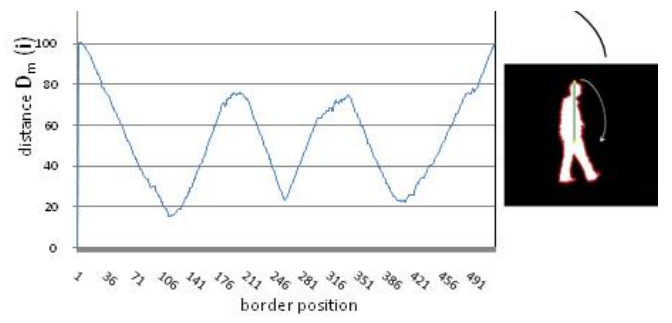Breadcrumb

Automated Cell-Type Classification and Death-Detection of Spinal Motoneurons
Spinal motoneurons (MNs) play a crucial role in movement control. Decoding the firing activity of spinal MNs could help in real-life challenges, such as enhancing the control of myoelectric prostheses and diagnosing neurodegenerative diseases. In this paper, we propose a machine learning approach to automatically classify MNs based on their firing activity. Applying the proposed approach to data from a MN computational model, the classification accuracy of all examined datasets exceeded 95%. We extended the approach to detecting the death of a given MN type using clustering validity index
Segmentation of Choroidal Neovascularization lesions in fluorescein angiograms using parametric modeling of the intensity variation
Choroidal Neovascularization (CNV) is a severe retinal disease characterized by abnormal growth of blood vessels in the choroidal layer. Current diagnosis of CNV depends mainly on qualitative assessment of a temporal sequence of fundus fluorescein angiography images. Automated segmentation and identification of the CNV lesion types (either occult or classic) is required to reduce the inter-and intra- observer variability and also to reduce the manual segmentation effort and time. In this work, we present automatic segmentation method for the CNV lesions. The method is based on developing a
Segmentation of choroidal neovascularization in fundus fluorescein angiograms
Choroidal neovascularization (CNV) is a common manifestation of age-related macular degeneration (AMD). It is characterized by the growth of abnormal blood vessels in the choroidal layer causing blurring and deterioration of the vision. In late stages, these abnormal vessels can rupture the retinal layers causing complete loss of vision at the affected regions. Determining the CNV size and type in fluorescein angiograms is required for proper treatment and prognosis of the disease. Computer-aided methods for CNV segmentation is needed not only to reduce the burden of manual segmentation but
Detection of Mammalian Coding Sequences Using a Hybrid Approach of Chaos Game Representation and Machine Learning
Mammalian protein-coding sequence detection provides a wide range of applications in biodiversity research, evolutionary studies, and understanding of genomic features. Representation of genomic sequences in Chaos Game Representation (CGR) helps reveal hidden features in DNA sequences due to its ability to represent sequences in both numerical and graphical levels. Machine learning approaches can automatically detect hidden patterns in CGR images by detecting and classifying protein-coding and noncoding patterns accurately. Here, we propose a pipeline that automatically detects coding (exons)
Classification of cardiac magnetic resonance image type and orientation
Cardiac magnetic resonance imaging provides a number of different imaging acquisition types and views of different body cross sections and orientations. A huge amount of images are produced which demand an automatic method for classification based on the visual contents to facilitate diagnosis and searching operations. In this work, we propose a fully automated classification method for classifying cardiac MRI images according to image acquisition type and orientation. Local binary pattern is used to represent the texture differences among the different image types. Edge orientation histogram

Body and visual sensor fusion for motion analysis in Ubiquitous healthcare systems
Human motion analysis provides a valuable solution for monitoring the wellbeing of the elderly, quantifying post-operative patient recovery and monitoring the progression of neurodegenerative diseases such as Parkinson's. The development of accurate motion analysis models, however, requires the integration of multi-sensing modalities and the utilization of appropriate data analysis techniques. This paper describes a robust framework for improved patient motion analysis by integrating information captured by body and visual sensor networks. Real-time target extraction is applied and a
Cardiac MRI view classification using autoencoder
The growing interest of using cardiac Magnetic Resonance Imaging (MRI) to assess the heart function and structure results in creating huge cardiac image databases. Due to the lack of standard meta-data description of the images, content-based classification of the cardiac images is essential to manage such databases. In particular, cardiac view classification is becoming an important stage for medical image analysis; efficient content-based retrieval as well as CAD systems. The major challenge in such classification lies in the large variability in image appearance caused by variation of
Convolutional Neural Network with Attention Modules for Pneumonia Detection
In 2017, pneumonia was the primary diagnosis for 1.3 million visits to the Emergency Department (ED) in the United States. The mortality rate was estimated to be 5%-10% of hospitalized patients, whereas it rises to 30% for severe cases admitted to the Intensive Care Unit (ICU). Among all cases admitted to ED, 30% were misdiagnosed, and they did not suffer from pneumonia, which raises a flag for the need for more accurate diagnosis methods. Several methods for pneumonia detection were recently developed using AI in general and more specifically, using deep neural networks. Even though it worth

Segmentation of ascending and descending aorta from magnetic resonance flow images
In this work, we propose an algorithm for segmenting the ascending and descending aorta from magnetic resonance phase contrast images, also referred to as MR flow imaging. The proposed algorithm is based on the active contour model combined with some refinements. In addition, false segmentation results due to severe image artifacts are automatically detected and corrected. The developed algorithm features three practical advantages: (1) fast; (2) requires minimal user interaction; and (3) robust to the changes in the algorithm parameters (e.g. same parameter set is used for all datasets). The
Cardiac MRI steam images denoising using bayes classifier
Imaging of the heart anatomy and function using magnetic resonance imaging (MRI) is an important diagnosis tool for heart diseases. Several techniques have been developed to increase the contrast-to-noise ratio (CNR) between myocardium and background. Recently, a technique that acquires cine cardiac images with black-blood contrast has been proposed. Although the technique produces cine sequence of high contrast, it suffers from elevated noise which limits the CNR. In this paper, we study the performance and efficiency of applying a Bayes classifier to remove background noise. Real MRI data is
Pagination
- Previous page ‹‹
- Page 4
- Next page ››
